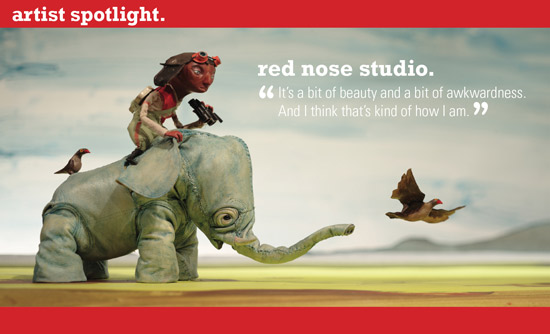
Raised on a small dairy farm in Indiana, Chris Sickels is the unstoppable creative force behind Red Nose Studio. His three-dimensional scenes are built to become two-dimensional photographs, so his work must combine multimedia sculpture with photography and illustration. His love of patina, the quality of a visibly aged surface, means that his work is exquisitely detailed, down to the faux rust of a motorcycle and the worn patch on a wool sweater. To top it off every 'puppet' has the signature red nose, which brings a rosy dose of whimsy to each expressive face.
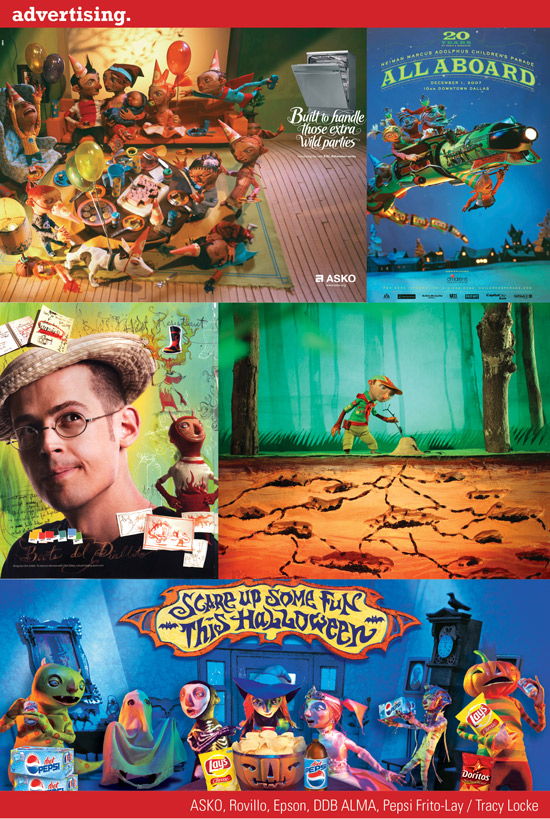
A rough hewn charm distinguishes Red Nose Studio's hand crafted puppets and meticulously detailed sets. The endearing figures are long limbed and top-heavy. His sets are built with wood, cardboard, twine, and found objects, all of which give his art its rough and tumble aesthetic, while his up-close-and-personal photography brings out the details in the craftsmanship, the texture of the hand-sewn clothes, and the subtle nuances of expression. Whimsical, fantastical, and otherworldly, Red Nose Studio's work never fails to fascinate.
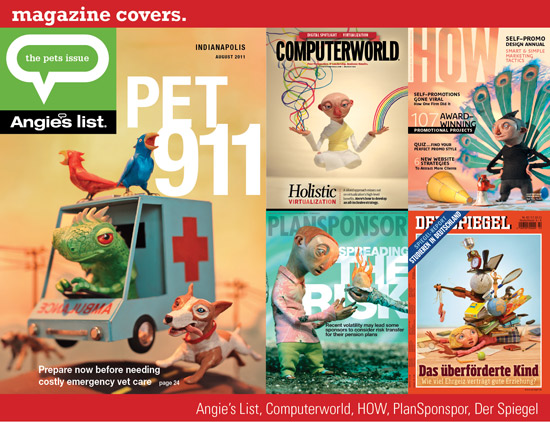
"I started making craft as a child, because we really couldn't afford many toys. I made a little puppet sometime around 1996, his name is Raydon, he is the genesis of it all." After a childhood of artistic tinkering, Chris found his way to the Art Academy of Cincinnati, where he learned a few of the tools of his trade - fabricating, sewing, and drawing. His interest in sculpture and photography developed later, and eventually merged with his art school skillset to shape Chris's unique style. Today, he sketches his figures in his studio and bakes the polymer clay hands and faces in his kitchen oven. The walls of his studio are lined with hand-crafted puppets and knick knacks waiting to be incorporated into his next project.
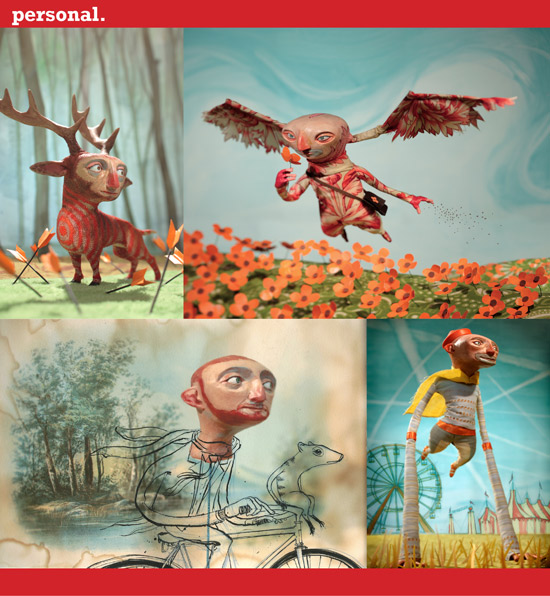
Chris started out as a 2D illustrator before experimenting with 3D art. One of his first sketches for a 3D rocket man was rejected by an art director, but Chris decided to create the figure anyway for self-promotion. "What I was doing didn't seem all that practical, like strapping a rocket to your back," he remembers. But like the rocketman, Chris told himself "I'm going to try it anyway." Seventeen years later, Chris's 3D art has developed into an award-winning style and an eye-catching genre of illustration.
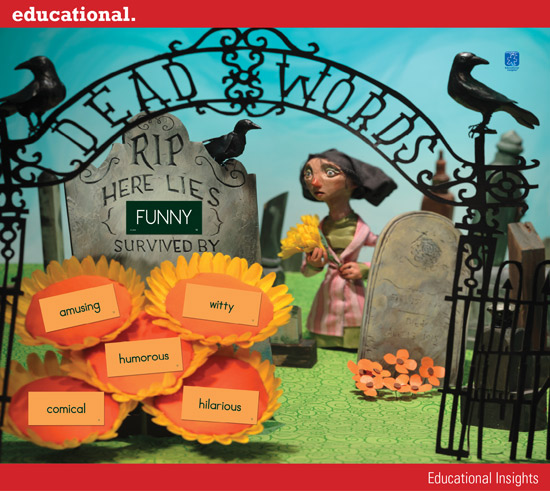
Chris always begins his process with a sketch. The drawing not only helps art directors see where the work is heading, but it is also where Chris fine-tunes his characters' postures and facial expressions. When Chris moves on to crafting the puppet, he carries the details of the sketch over into the sculpture, paying careful and special attention to the face. He explains that, "In a lot of my pieces, the characteristics in the face are the soul of it. So the face is usually one of the first things to get done."
"The objects take the pieces in different directions," Chris says. "It's not always in your complete control. So you have to work with the objects instead of trying to bend the objects to fit your idea." There's a spontaneity in his work that stems from this improvisation of objects, and by bowing to his obstacles, Chris is able to concoct new and exciting visual solutions. For one project, Chris designed a vacuum cleaner from a garlic press, a tire gauge, and the cord from an old electric skillet.
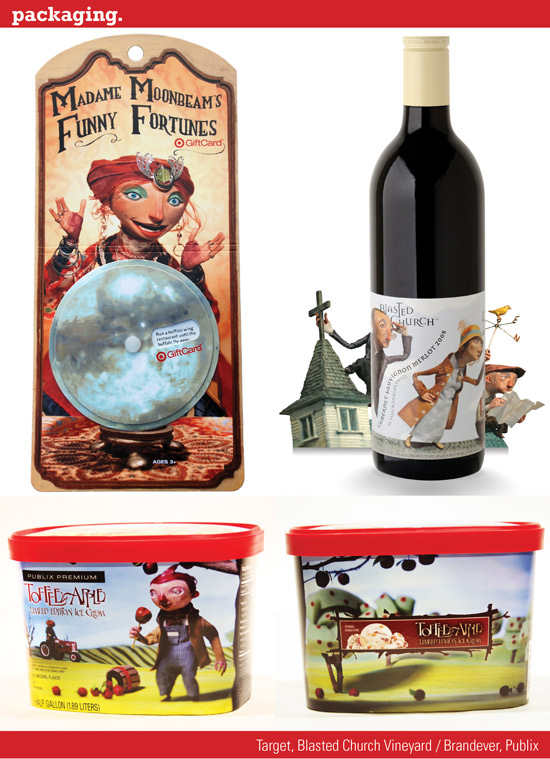
Chris describes his work, saying "The sculptures sometimes look pretty crude, or the stitching is really rough, or the buildings are painted really sloppily. They're not poetic, there's no rhythm to them, there's no math to them like a good poem. But that's how my work is. My work isn't really graceful. It's usually pretty awkward - like if the puppet moved, he'd fall off or he'd trip or he'd run into a wall. It's a bit of beauty and a bit of awkwardness. And I think that's kind of how I am."
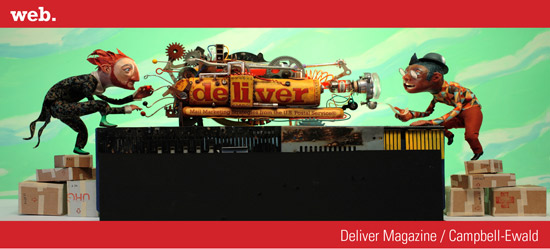
In 2004, Chris collaborated with Planet 10, an Indianapolis design firm, and Quality Printing, a local printing company to create the Red Thread Project. The book showcased the capabilities of illustration, design, and printing in a uniquely developed collaboration that utilized the creative faculties of all talents involved. On one page, the printer used a spot gloss UV for a scene involving rain. The slick coating emphasizing the wetness of the water and highlighting the quality of light reflecting off puddles of rain. The book also incorporated printing techniques like embossing, debossing, silkscreening, die-cutting, and spot-varnishing to enhance the viewing experience in synergy with Chris's illustrations. The project won Best in Show in the HOW Magazine Self-Promotion annual and was a HOW Magazine Perfect 10 winner. "We see many join promotions," commented HOW editor Bryn Mooth, "but this one works to an astonishing degree. Every component - the illustration, copywriting, design and printing - works in harmony It's an enchanting piece, a real keeper, and it shows every participant's considerable skill to maximum advantage."
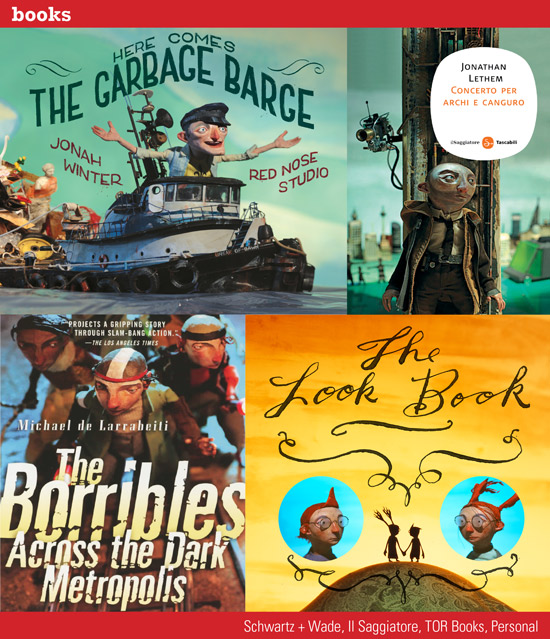
Red Nose Studio illustrations appear in advertising, magazines, books, newspapers, packaging, character development and animation. His advertising clients include AIGA, Frito Lay, Nickelodeon, Target, Pepsi, Neiman Marcus, Microsoft, Epson, Kraft, and IBM. He has also illustrated book covers for Tor, Scholastic, Osborne McGraw-Hill, and he is in the middle of illustrating his second children's book for Schwartz & Wade, a Random House imprint. His editorial work, many covers included, has appeared in Computerworld, Business Week, The Boston Globe, Angie's List, Forbes, The New York Times, the Washington Post, the Wall Street Journal, Wired, and many others.
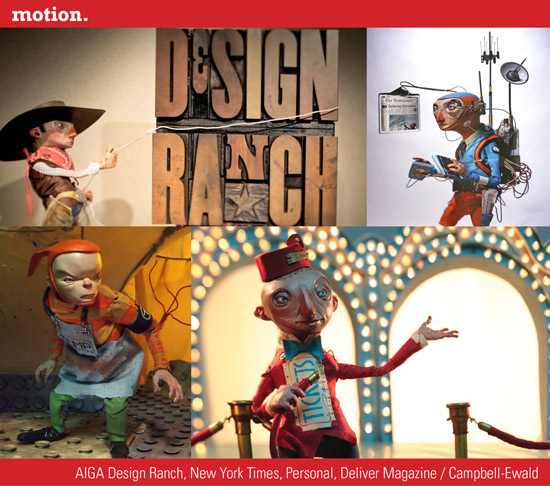
Chris's work has been honored by virtually every industry award institution, including Society of Publication Designers, American Illustration, Communication Arts, and Society of Illustrators. His art has been featured in How, Print, Creativity and 3x3 Magazine, as well as in a number of art and design books, such as Taschen's Illustration Now!. He has twice been honored with the Carol Anthony Grand Prize award from the Society of Illustrators 3-D Salon. Two of his short films, The Red Thread Project and Innards were selected to screen at the 2005 and 2006 Los Angeles International Short Film Festival.
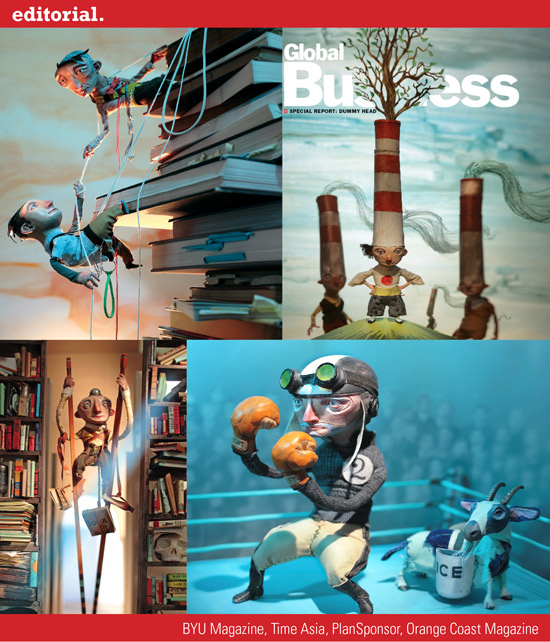
Megan Lane Patrick, senior editor of HOW Magazine, stated that Chris "filters life through his special lens and transforms it into beautiful sculpture, and then an image," and "Yes, he has a bit of a dark sensibility, but that appeals to me." To read more about Chris, visit his blog at rednosestudio.com.
Click here for downloadable items - desktop wallpapers and a high-res printable letter sized promo.
Q&A with Red Nose Studio
Can you tell us a little bit about how you create your puppets and your sets? It all starts with the drawings, the approved sketch is the blueprint for what is built. The set is constructed through the camera viewfinder, this allows elements to be built to fit the 2D composition and keeps the building to a minimum much like a theater set. Materials vary, using whatever I have on hand to create what is needed. I like to use materials that have a specific texture, pattern or patina that allow image to have visual textures that go beyond traditional sculpture. To accommodate the size of the studio most figures are about 7 inches tall and the sets generally live on a 4 x 4 foot table. Most backgrounds are painted on large paper. Contrary to popular belief, most images take a minimum of 150 test shots to get positioning, composition, lighting, etc. refined for the final. Most of the effects are done 'in camera' on the set with minimal post editing.
Sometimes you use found objects in your art (buttons, gears, etc). Where do you like to go hunting for knick knacks? It is almost a disease, I am always looking for stuff to pick up. Thrift shops, sidewalks, the recycle bin, my children's broken toys get dismantled and filed into my junk boxes. One time I even bought a product of the shelf just to use part of the clear bubble packaging in a piece.
Photography is an important element in your work. What are some of the challenges and quirks that come with using photography as an illustrator? The biggest quirk is that even though elements are hand painted and specific fabrics are used, the colors of those elements always seem to shift and change under particular lighting arrangements. That can lead to happy accidents, but can also lead to frustrating and unforeseen outcomes. In those cases you have to roll with it and figure out ways to make it work to your advantage.
Your sets can be quite elaborate, from urban cityscapes to beachside carnivals. What has been the most difficult set to create, to date? This winter I was commissioned to create a scene with a large iceberg that was to be seen both above and underwater in the same scene. The tough part was finding materials that would give me the effect of ice and water without actually using ice and water. It required a large set probably 3 times the size I normally work, not that bigger is necessarily harder, sometime the simplest sets are just as hard as elements are harder to cheat when there is less going on.
How long does it usually take to create a puppet and build a set? It all depends on the complexity and time constraints of the project. A puppet can be built in as little as 8 hours or much longer. Sets can also range dramatically. Illustrations have been completed in as little as 24 hours or as long as two weeks.
You've chosen to live and work in the cozy Midwestern town of Greenfield, Indiana. How does your environment affect your work, your schedule, your sources of inspiration? I like to work alone, so being in a sleepy town is fine with me. I try to keep the schedule as regular as possible so hopefully my children will realize they had a father growing up. Greenfield can be a 'little' on the subdued side and I can understand that most folks would ask how do I draw inspiration from an uninspiring environment? Just last night some fella strolled by the house dressed all in white while strumming a guitar. Now I realize that in NYC that would hardly even get noticed, but when you put that guy in sleepy Greenfield, that juxtaposition can stir up lots of connotations.
You're often asked to capture moments of emotion - surprise, fear, triumph, etc. What are your tips for sculpting emotionally expressive faces? It all comes from the sketches, if the drawing has a gesture and expression to it then I use it to lead the sculpture. I am not a skilled sculptor, I cannot just 'will' a figure out of stone, so I have to rely on the sketch to tell me what to do.
Who are a few of your favorite artists and illustrators? Tim Hawkinson, Alexander Calder, Alan E Cober, along with numerous peers who create work that drives me to better my own work.
How has the illustration industry changed since you became a professional illustrator? How do you see it changing in the future? My first commissioned illustration was in 1995. No internet, websites, emails... I remember saving up to buy a $300 fax machine, because without a fax you had to use smoke signals. Using FedEx to deliver paintings done on a flexible surface for drum scanning. Seems like everything has changed. I have seen art directors loose their creative drive due to overreaching bosses and I have seen art directors flourish because of the trust and confidence that their bosses have in them. I have seen illustrators become hands and I have experienced that myself on occasion. I have seen the rise of the computer as the ultimate tool, I have seen the hand made rebellion against the computer and now I see that folks are coming around and seeing the computer as a tool and not an end. I have seen techniques come and go, but IDEAS are what always surface to the top. I was taught that the illustrator needs to be a content provider and not just a decorator... even after 17 years I still believe that is where the future is.
